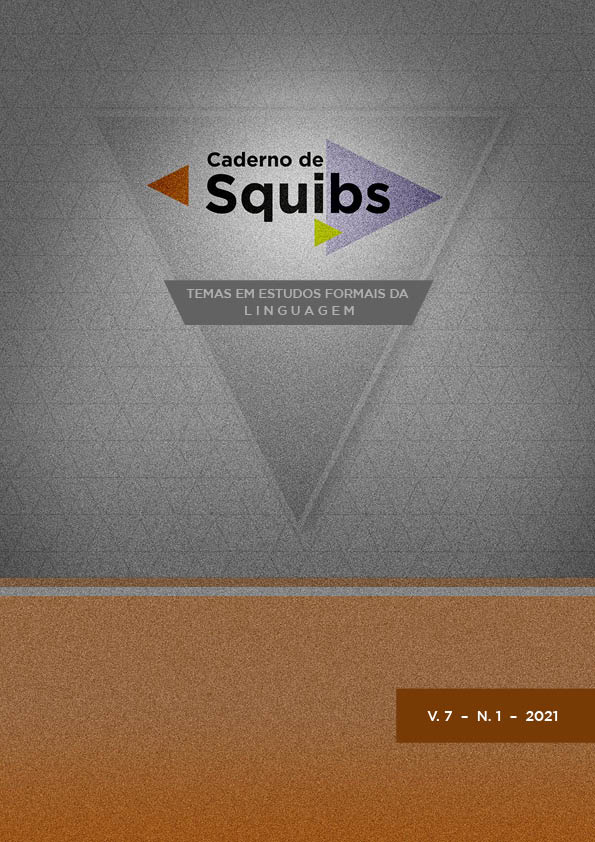Coreferential pronouns in ‘gerund’ predicates in Tupí-Guaraní languages: a formal approach
Palavras-chave:
gerund clauses, coreferentiality, agreement, Tupí Guaraní familyResumo
This study investigates the syntax of coreferential pronouns in gerund clauses in Tupí-Guaraní languages, considering particularly the Kamaiurá language. As pointed out in the Tupinian literature, the distribution of person markers/pronouns in gerund constructions is determined by the semantic class of the predicate, which in turn interacts with the transitivity of the predicate and with a system of person hierarchy, giving rise to direct/inverse order. Assuming Zubizarreta and Pancheva’s (2017) model of person marking in Paraguayan Guaraní in root/matrix clauses, we propose that gerund constructions with intransitive and transitive predicates are projections of the functional heads INFL/v and D/INFL/v, respectively. In these configurations, INFL and v are specified for an interpretable person feature, which enters an agreement relation with a D feature on the gerund predicate, giving rise to a direct/inverse system, respectively, under a condition on the fixed interpretation of tense in this context.
Downloads
Referências
ALEXIADOU, A. Functional Structure in Nominals: Nominalization and Ergativity. Amsterdam/Philadelphia: John Benjamins Publishing Company, 2001.
CABRAL, A. S. C.; RODRIGUES, A. D. O desenvolvimento do gerúndio e do subjuntivo em Tupí-Guaraní. In: RODRIGUES, A. D.; CABRAL, A. S. C. (ed.) Novos estudos sobre línguas indígenas. Brasília: Editora da UnB, 2005. p. 47-58.
LANDAU, I. Elements of control: structure and meaning in infinitival constructions. Dordrecht: Kluwer Academic Publishers, 2000.
LECARME, J. Nominal Tense and Tense Theory. In: CORBLIN, F. et al. (org.). Empirical Issues in Formal Syntax and Semantics. v. 2. (CSSP, 1997). The Hague: Holland Academic Graphics, 1999. p. 333-354. Available in: <https://www.academia.edu/2486019/Nominal_Tense_and_Tense_Theory>. Access in: March 1st, 2022.
MAGALHÃES, M. S. O gerúndio em Guajá. In: RODRIGUES, A. D.; CABRAL, A. S. C. (ed.). Línguas e Culturas Tupí. v. 1. Campinas, SP: Curt Nimuendajú; Brasília: LALI/UnB, 2007. p. 349-355.
RODRIGUES, A. D. Morfologia do verbo Tupí. Letras 1, separata, Curitiba, 1953.
RODRIGUES, A. D. Línguas brasileiras: para o conhecimento das línguas indígenas. São Paulo: Loyola, 1994.
SALLES, H. Subordinação em línguas da família Tupí-Guaraní. In: CABRAL, A. S. A. C.; RODRIGUES, A. D. (org.) Atas do I Encontro Internacional do Grupo de Trabalho sobre Línguas Indígenas da ANPOLL. Belém, PA: Editora da UFPA, 2002, p. 418-424.
SALLES, H. Foricidade e marcação de pessoa em línguas da família Tupí-Guaraní. In: A. D. Rodrigues; A. S. C. Cabral (ed.). Línguas e Culturas Tupí. v. 1. Campinas, SP: Curt Nimuendajú; Brasília: LALI/UnB, 2007. p. 417-425.
SEKI, L. Gramática do Kamaiurá: Língua Tupí-Guaraní do Alto Xingu. Campinas, SP: Editora da UNICAMP/São Paulo: Imprensa Oficial, 2000.
TONENHAUSER, J. Temporal reference in Paraguayan Guaraní, a tenseless language. Linguistics and Philosophy, n. 34, p. 257-303, 2011.
VIEIRA, M. D. As construções com concordância múltipla em Guaraní. In: CABRAL, A. S. C.; RODRIGUES, A. D. (org.). Línguas indígenas brasileiras: fonologia, gramática e história. Tomo 1. Belém, EdUFPa, 2002. p. 425-433.
ZUBIZARRETA, M-L; PANCHEVA, R. A formal characterization of person-based alignment. The case of Paraguayan Guaraní. Natural Language and Linguistic Theory, v. 35, p. 1161-1204, 2017. DOI: <https://doi.org/10.1007/s11049-016-9357-5>.
Downloads
Publicado
Edição
Seção
Licença
Copyright (c) 2022 Caderno de Squibs: Temas em estudos formais da linguagem

Este trabalho está licenciado sob uma licença Creative Commons Attribution-NonCommercial 4.0 International License.
Autorizo a publicação de squib/artigo de minha autoria e inteira responsabilidade para publicação.
I authorize the publication of the squib/paper of my authorship and full responsibility for publication.


